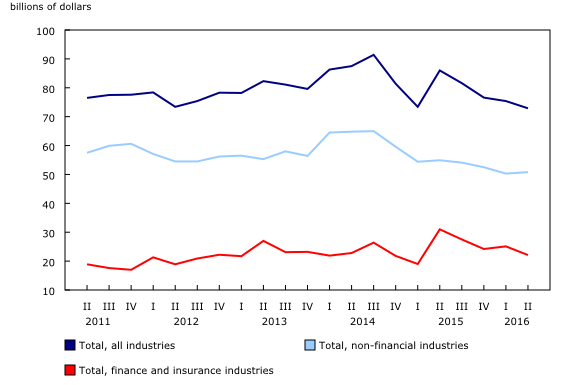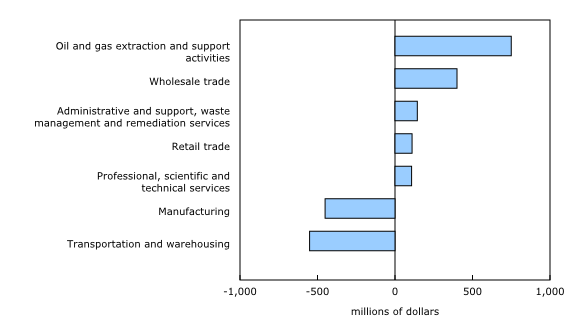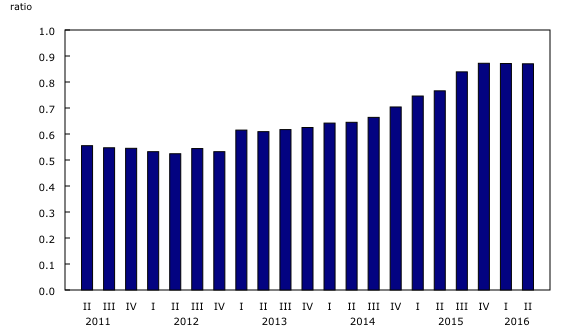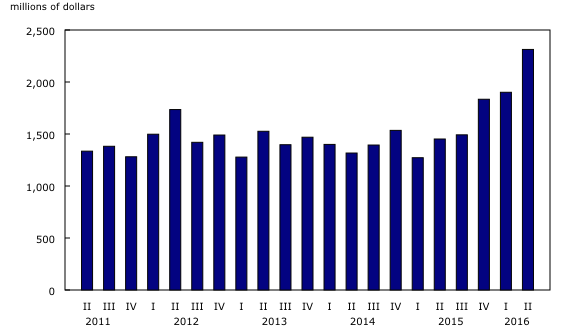Quarterly financial statistics for enterprises, second quarter 2016
Archived Content
Information identified as archived is provided for reference, research or recordkeeping purposes. It is not subject to the Government of Canada Web Standards and has not been altered or updated since it was archived. Please "contact us" to request a format other than those available.
Released: 2016-08-25
$72.9 billion
Second quarter 2016
-3.4% 
(quarterly change)
Canadian corporations earned $72.9 billion in operating profits in the second quarter, down 3.4% from the previous quarter. The decrease was attributable to a $3.2 billion decline in profits for insurance carriers.
Year over year, overall operating profits for Canadian corporations fell 15.3% compared with the second quarter of 2015.
Non-financial industries
In the non-financial sector, operating profits edged up 0.9% to $50.8 billion in the second quarter on stable operating revenues. Overall, profits were down in 8 of 17 non-financial industries.
Losses persist in the energy sector
The oil and gas extraction industry reported an operating loss of $4.2 billion in the second quarter. This loss was smaller than the $4.9 billion operating loss incurred in the first quarter. As a result, operating profits in the oil and gas extraction industry grew by $750 million. The operating loss in the second quarter was the sixth consecutive quarterly operating loss for the oil and gas extraction industry. Both quarterly losses in 2016 were larger than those in 2015.
Petroleum and coal product manufacturing posted its second consecutive quarterly operating loss, recording an operating loss of $788 million in the second quarter, following an operating loss of $858 million in the first quarter. These two losses were the industry's first in 23 years.
Collectively, the energy sector—oil and gas extraction, and petroleum and coal product manufacturing—posted an operating loss of $5.0 billion in the second quarter, smaller than the operating loss of $5.8 billion in the first quarter.
Continued losses in the energy sector were associated with weaker world oil prices. Weak global economic growth has contributed to the current low price environment. Heavy crude oil prices have traded below their long-term average since late 2014.
Leverage, as measured by the debt-to-equity ratio, has risen in the energy sector since the second quarter of 2013, as debt levels have increased steadily. The rise in this ratio accelerated in 2015, as retained earnings were eroded by continued operating losses due to declines in crude oil prices.
Operating profits up in wholesale and retail trade
Operating profits were up 7.1% to $6.1 billion in wholesale trade in the second quarter, with most of the growth attributable to motor vehicle and parts wholesalers and, to a lesser extent, machinery and equipment wholesalers.
In the retail sector, operating profits rose 2.5% to $4.5 billion. Gains in operating profits were most pronounced for clothing, department and other general merchandise stores. Operating profits for motor vehicle and parts dealers also increased in the second quarter.
Operating profits down in manufacturing and transportation
In manufacturing, operating profits were down 4.4% to $9.8 billion in the second quarter, as operating expenses grew 0.7% and operating revenue rose 0.4%. Operating profits fell in 7 of 13 manufacturing industries, with food and soft drink manufacturing posting the largest decline, down 22.8% to $1.3 billion. Excluding food and soft drink manufacturing, overall operating profits in manufacturing edged down from the first quarter to the second quarter.
Transportation and warehousing reported a $551 million decrease in operating profits to $5.1 billion, with all of the decline attributable to the transportation industry.
Financial industries
Operating profits decline in the financial sector
Overall operating profits in financial industries fell 12.1% from $25.1 billion in the first quarter to $22.1 billion in the second quarter.
The decrease in operating profits was attributable to a 5.5% increase in operating expenses, which reflected a high volume of disaster claims filed with property and casualty insurers. From the first quarter to the second quarter, these claims increased by $1.4 billion, mainly because of the damage caused by the wildfire in Fort McMurray in May.
In a recent report published in July, the Insurance Bureau of Canada stated that the wildfire was the costliest insured natural disaster in Canadian history. As a result, operating profits for property and casualty insurers decreased 130.0% from $1.4 billion in the first quarter to a $410 million loss in the second quarter.
Operating revenue in the financial sector edged up 0.9%, as gains from financial derivatives and dividend income were tempered by a drop in net interest revenue, among other things.
Increase in provisions for loss in the financial sector
The value of enterprises' outstanding credit (defined as loans and other borrowings plus mortgages) with banks and other financing enterprises continued to increase, totalling $941.9 billion in the second quarter. With interest rates remaining at their lowest levels, growth in commercial credit expanded, especially for non-financial enterprises, where the value of outstanding credit rose from $776.8 billion to $803.2 billion on a year-over-year basis.
The debt-to-equity ratio for the energy sector has risen in recent years, partly because conditions in petroleum markets have had a major adverse effect on the profits of enterprises operating in this sector. At the same time, financial institutions (mainly banks), anticipating heightened risks on their assets, increased their provisions for losses by 59.3% year over year, from $1.5 billion in the second quarter of 2015 to $2.3 billion in the second quarter of 2016. According to the most recent data from the Biannual Survey of Suppliers of Business Financing, some banks have begun to tighten their lending to oil and gas enterprises.
Note to readers
Quarterly financial statistics are compiled using financial information provided by enterprises, which derive these data from their financial statements. Starting January 1, 2011, Canadian publicly accountable enterprises were required to replace Canadian Generally Accepted Accounting Principles (CGAAP) with International Financial Reporting Standards (IFRS) when preparing their financial statements for fiscal years starting on or after January 1, 2011. Canadian private enterprises were required to replace CGAAP with Accounting Standards for Private Enterprises or IFRS. The adoption of new accounting standards by some enterprises since the beginning of 2011 may affect the comparability of data with those of prior periods.
Data on quarterly profits in this release are seasonally adjusted and expressed in current dollars. Financial data for the first quarter of 2016 have been revised.
For information on seasonal adjustment, see Seasonally adjusted data – Frequently asked questions.
Quarterly financial statistics for enterprises are based on a sample survey and represent the activities of all corporations in Canada, except those that are government-controlled or not-for-profit. An enterprise can be a single corporation or a family of corporations under common ownership and/or control, for which consolidated financial statements are produced.
Profits referred to in this analysis are operating profits earned from normal business activities. For non-financial industries, operating profits exclude interest and dividend revenue and capital gains/losses. For financial industries, these are included, along with interest paid on deposits.
In this release, all profits are operating profits unless otherwise stated. Operating profits differ from net profits, which represent the after-tax profits earned by corporations.
Real-time CANSIM tables
Real-time CANSIM tables 187-8001 and 187-8002 will be updated on September 9. For more information, consult the document, Real-time CANSIM tables.
Next release
Financial statistics for enterprises for the third quarter will be released on November 24.
Products
Aggregate balance sheet and income statement data for Canadian corporations are now available in CANSIM at the national level for 22 industry groupings.
The publication Quarterly Financial Statistics for Enterprises (61-008-X) is no longer released. Data from the Quarterly Survey of Financial Statements are available in CANSIM.
Contact information
For more information, contact us (toll-free 1-800-263-1136; 514-283-8300; STATCAN.infostats-infostats.STATCAN@canada.ca).
To enquire about the concepts, methods, or data quality of this release, contact Philippe Marceau (613-864-8790; philippe.marceau@canada.ca) or David Sabourin (613-866-8152; david.sabourin2@canada.ca), Industrial Organization and Finance Division.
- Date modified:





